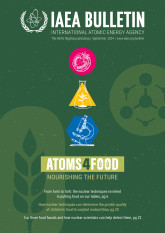We need to grow more food, and we need to do it better. We need food to be more nutritious, to grow in more difficult places, to be more resilient to weather extremes and to be safer for human consumption.
Millions of people are going to bed hungry, in every corner of the world. The number facing high levels of food insecurity has more than doubled since 2020. Climate extremes threaten to increase the number of crop failures, making it even more difficult to meet increasing global demand.
We have the tools to change that. Nuclear science is a tool that helps us to cultivate stronger, healthier, safer and more nutritious crops.
The IAEA and the Food and Agriculture Organization of the United Nations (FAO), through the Joint FAO/IAEA Centre of Nuclear Techniques in Food and Agriculture, are developing these tools and helping those who need them most to learn how to apply them.




